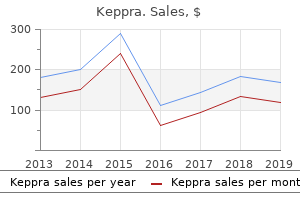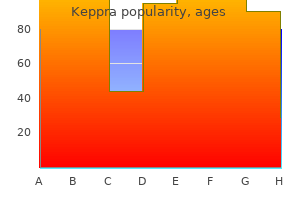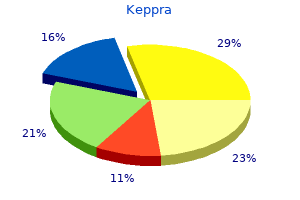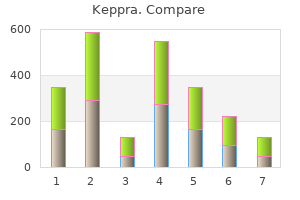


OLSSON'S IS CLOSED
Thank you to all our loyal customers who supported us for 36 years
"Purchase keppra 250 mg online, medicine 831".
By: C. Ashton, MD
Clinical Director, University of California, San Diego School of Medicine
Which of the next contributes directly to medications during pregnancy chart generic keppra 250mg on-line the generation of a hypertonic medullary interstitium in the kidney Which of the next is a part of the renal response to metabolic acidosis The afferent arterioles of the juxtamedullary nephrons give rise to a lot of the vasa recta treatment head lice order keppra 500mg with visa. Just from the theoretical description of Tm-limited reabsorptive mechanisms within the text in treatment online cheap keppra 500 mg otc, listing a quantity of attainable causes medicine emblem cheap 500mg keppra amex. The focus of urea in urine is all the time a lot larger than the focus in plasma. A young girl who has suffered a head harm appears to have recovered but is thirsty on a daily basis. A affected person has a tumor within the adrenal cortex that constantly secretes giant amounts of aldosterone. What is this condition called, and what effects does this have on the whole quantity of sodium and potassium in her body Remember that Na1 reabsorption by the proximal tubule is achieved by Na1/H1 countertransport. Remember that overuse of diuretics can result in an increase in plasma aldosterone concentration and to potassium depletion. A general precept of physiology is that structure is a determinant of-and has coevolved with-function. How does the anatomy of the renal corpuscle and related constructions decide perform Give one example every of how a legislation of chemistry and a law of physics are essential in understanding the regulation of renal operate. How does the control of vasopressin secretion spotlight the general principle of physiology that most physiological features are managed by a number of regulatory methods, usually working in opposition The continuous water reabsorption would trigger a lower in plasma sodium concentration (hyponatremia) due to dilution of sodium. The resultant enhance in Na1 and water excretion would decrease blood pressure, resulting in a reflexive improve in renin secretion. However, during extreme decreases in plasma quantity, like in dehydration, the denervated kidney might not produce adequate renin to maximally lower Na1 excretion. This would end in a decrease within the elimination of poisonous substances from the blood. If this only occurred in a quantity of glomeruli, it might not have a significant impact on renal perform because of the massive number of complete glomeruli in the two kidneys providing a security issue. The osmotic pressure of sodium will carry water with it, thus rising urine output. The ability to detect a decrease in plasma quantity by low-pressure baroreceptors in the coronary heart (see Chapter 12) and a rise in osmolarity by osmoreceptors in the mind sets in motion a coordinated response to reduce the loss of physique water and ions together with Na1. The increased focus of plasma aldosterone will increase renal Na1 reabsorption. The increased synthesis of vasopressin within the hypothalamus and its launch from axons in the posterior pituitary results in an increase in vasopressin within the blood that indicators the kidneys to improve water reabsorption. Therefore, the coordination of organs from the nervous system (the brain), endocrine system (posterior pituitary), circulatory system (heart), and urinary system (kidneys) minimizes the lack of water and Na1 during sweating until the deficits of each may be replaced by increased ingestion and absorption within the gastrointestinal tract. As described in Chapter 1, when the acquire of a substance exceeds its loss, one is in a constructive stability for that substance. For that reason, exact homeostatic control mechanisms exist to preserve whole-body K1 balance. Small will increase in plasma K1 have a direct impact in the kidneys to improve K1 secretion. Furthermore, small increases in plasma K1 stimulate the discharge of aldosterone from the adrenal cortex, which, in flip, stimulates K1 secretion in the kidneys. The direct impact of increased K1 and the renal impact of aldosterone act to normalize K1 balance. The failure of the adrenal cortex to produce enough aldosterone in response to an increase in plasma K1 (as in primary adrenal insufficiency, see Section eleven. The patient is hypoxic, which, with normal lung function, normally leads to hyperventilation and respiratory alkalosis. Therefore, the patient is more likely to have chronic lung disease resulting in hypoxemia and retention of carbon dioxide (hypercapnia).

Hepatic glycogenolysis begins within seconds of an applicable stimulus medicine 627 purchase keppra with amex, such as sympathetic nervous system activation medicine prescription purchase keppra 250 mg fast delivery. Glycogenolysis also happens in skeletal muscle medicine 0829085 purchase keppra with mastercard, which incorporates roughly the same amount of glycogen because the liver symptoms bronchitis buy keppra cheap online. Some of the lactate, nonetheless, enters the blood, circulates to the liver, and is used to synthesize glucose, which might then depart the liver cells to enter the blood. The catabolism of triglycerides in adipose tissue yields glycerol and fatty acids, a process termed lipolysis. Thus, an essential source of glucose in the course of the postabsorptive state is the glycerol launched when adiposetissue triglyceride is damaged down. A few hours into the postabsorptive state, protein becomes another supply of blood glucose. Large portions of protein in muscle and other tissues could be catabolized with out severe mobile malfunction. Some carbohydrate is saved as glycogen in liver and muscle, however most carbohydrates and fat in excess of that used for vitality are saved as fat in adipose tissue. The remaining amino acids in dietary protein are used for vitality or converted to fat. How is that this principle apparent in the metabolic occasions of the postabsorptive state Before this point is reached, however, protein breakdown can supply large quantities of amino acids. These amino acids enter the blood and are taken up by the liver, where some may be metabolized through the a-keto acid pathway to glucose. Synthesis of glucose from such precursors as amino acids and glycerol is named gluconeogenesis-that is, "creation of recent glucose. Although traditionally this process was thought-about to be almost completely carried out by the liver with a small contribution by the kidneys, latest proof strongly suggests that the kidneys contribute rather more to gluconeogenesis than beforehand believed. Glucose Sparing (Fat Utilization) the roughly 180 g of glucose per day produced by gluconeogenesis within the liver (and kidneys) during fasting supplies about 720 kcal of energy. As described later in this chapter, typical complete vitality expenditure for a mean adult is 1500 to 3000 kcal/day. An adjustment should subsequently happen in the course of the transition from the absorptive to the postabsorptive state. Most organs and tissues, other than these of the nervous system, considerably decrease their glucose catabolism and increase their fat utilization, the latter turning into the main power supply. This metabolic adjustment, often known as glucose sparing, "spares" the glucose produced by the liver for use by the nervous system. The essential step in this adjustment is lipolysis, the catabolism of adipose-tissue triglyceride, which liberates glycerol and fatty acids into the blood. We described lipolysis earlier by means of its significance in providing glycerol to the liver as a substrate for the synthesis of glucose. Now, we give consideration to the liberated fatty acids, which flow into bound to the plasma protein albumin, which acts as a carrier for these hydrophobic molecules. They provide vitality in two methods (see Chapter three for details): (1) They first endure beta oxidation to yield hydrogen atoms (that go on to participate in oxidative phosphorylation) and acetyl CoA, and (2) the acetyl CoA enters the Krebs cycle and is catabolized to carbon dioxide and water. One of the ketones is acetone, some of which is exhaled and accounts partially for the distinctive breath odor of people present process prolonged fasting. The web result of fatty acid and ketone utilization throughout fasting is the provision of vitality for the body while at the similar time sparing glucose for the brain and nervous system. Moreover, as just emphasized, the brain can use ketones for an power source, and it does so increasingly as ketones build up within the blood during the first few days of a quick. The survival worth of this phenomenon is critical; when the mind decreases its glucose requirement by utilizing ketones, a lot less protein breakdown is required to supply amino acids for gluconeogenesis. Consequently, the power to face up to a long fast with out critical tissue harm is enhanced. The mixed effects of glycogenolysis, gluconeogenesis, and the swap to fat utilization are so efficient that, after several days of complete fasting, the plasma glucose focus is decreased by only a few proportion factors.
Lateral inhibition produces a central space of excitation surrounded by an space by which the afferent information is inhibited medications held for dialysis generic keppra 500 mg visa. The sensation is localized to a extra restricted area than that during which all three units are literally stimulated symptoms appendicitis buy generic keppra 500mg on-line. Central Control of Afferent Information All sensory signals are subject to intensive modification on the numerous synapses along the sensory pathways before they reach larger levels of the central nervous system symptoms 5dpo generic keppra 250 mg amex. The reticular formation and cerebral cortex (see Chapter 6) medicine jokes buy cheap keppra 500 mg on-line, particularly, control the enter of afferent data by way of descending pathways. These chains of neurons journey in bundles of parallel pathways carrying info into the central nervous system. Some pathways terminate in components of the cerebral cortex responsible for conscious recognition of the incoming info; others carry info not consciously perceived. Sensory pathways are also called ascending pathways as a result of they project "up" to the brain. The central processes of the afferent neurons enter the mind or spinal cord and synapse upon interneurons there. The interneurons upon which the afferent neurons synapse are called second-order neurons, and these in turn synapse with third-order neurons, and so on, till the knowledge (coded action potentials) reaches the cerebral cortex. Most sensory pathways convey information about solely a single type of sensory information. For example, one pathway conveys information only from mechanoreceptors, whereas one other is influenced by info solely from thermoreceptors. The olfactory cortex is situated toward the midline on the undersurface of the frontal lobes (not seen in this picture). In other words, they point out that something is going on, without specifying just what or where. A given ascending neuron in a nonspecific ascending pathway might reply, for example, to enter from a number of afferent neurons, each activated by a unique stimulus, such as maintained pores and skin stress, heating, and cooling. The ascending pathways in the spinal wire and brain that carry information about single types of stimuli are often identified as the particular ascending pathways. Thus, information from receptors on the proper side of the physique is transmitted to the left cerebral hemisphere, and vice versa. The specific ascending pathways that transmit information from somatic receptors project to the somatosensory cortex. Somatic receptors are those carrying info from the pores and skin, skeletal muscle, bones, tendons, and joints. The particular ascending pathways from the eyes connect to a special major cortical receiving space, the visual cortex, which is in the occipital lobe. The particular ascending pathways from the ears go to the auditory cortex, which is within the temporal lobe. Specific ascending pathways from the taste buds move to the gustatory cortex adjacent to the area of the somatosensory cortex where information from the face is processed. The pathways serving olfaction project to portions of the limbic system and the olfactory cortex, which is situated on the undersurface of the frontal and temporal lobes. The area of affiliation cortex closest to the first sensory cortical space processes the data in pretty simple methods and serves primary sensory-related capabilities. Regions farther from the first sensory areas process the knowledge in more complicated ways. These include, for instance, greater contributions from areas of the mind serving arousal, attention, reminiscence, and language. Some of the neurons in these latter regions additionally combine enter concerning two or more kinds of sensory stimuli. Thus, an association area neuron receiving enter from both the visual cortex and the "neck" region of the somatosensory cortex may integrate visual information with sensory details about head position. Axons from neurons of the parietal and temporal lobes go to association areas in the frontal lobes and different elements of the limbic system. Through these connections, sensory information could be invested with emotional and motivational significance.
Buy generic keppra 250 mg. Atlas Genius - Back Seat (Unplugged At Music Feeds Studio).

Draw a picture of what every person would understand by way of each eye when taking a glance at a white wall symptoms 5 days before missed period buy keppra on line amex. Left visual field Right visual field Left eye Right eye Answer can be found at end of chapter medications vitamins keppra 500mg visa. The cells of the visible pathways are organized to handle information about line symptoms 10 weeks pregnant generic 500mg keppra visa, distinction medications 247 discount 250 mg keppra with mastercard, motion, and shade. We talked about earlier that some neurons of the visible pathway project to areas of the brain aside from the visible cortex. For example, a just lately found class of ganglion cells containing an opsinlike pigment referred to as melanopsin carries visual data to a nucleus within the hypothalamus referred to as the suprachiasmatic nucleus, which lies just above the optic chiasm and features as a half of the "biological clock. For example, an object appears red as a end result of it absorbs shorter (blue) wavelengths, whereas concurrently reflecting the longer (red) wavelengths. Light perceived as white is a mix of all wavelengths, and black is the absence of all light. Color vision begins with activation of the photopigments within the cone photoreceptor cells. Human retinas have three kinds of cones-one responding optimally at long wavelengths ("L" or "pink" cones), one at medium wavelengths ("M" or "green" cones), and the opposite stimulated best at short wavelengths ("S" or "blue" cones). Each kind of cone is labored up over a variety of wavelengths, with the best response occurring near the center of that range. For example, in response to gentle of 531 nm wavelength, the green cones reply maximally, the purple cones less, and the blue by no means. Our sensation of the shade of green at this wavelength relies upon upon the relative outputs of those three types of cone cells and the comparison made by higher-order cells in the visual system. In different words, they obtain input from all three types of cones, and so they sign not a specific color however, rather, basic brightness. The cell provides a weak response when stimulated with a white light as a end result of the light contains each blue and yellow wavelengths. The output from these cells is recorded by a number of, and as yet unclear, mechanisms in visual facilities of the mind. Our ability to discriminate shade additionally is dependent upon the intensity of light putting the retina. In brightly lit situations, the differential response of the cones permits for good color imaginative and prescient. Under brilliant lighting situations, the three types of cones respond over different frequency ranges. Hold very still and stare at the triangle contained in the yellow circle for 30 seconds. Thus, objects that seem vividly coloured in shiny daylight are perceived in shades of gray as evening falls and lighting turns into so dim that solely rods can reply. Color Blindness At excessive mild intensities, as in daylight vision, most people-92% of the male inhabitants and over 99% of the feminine population- have regular colour imaginative and prescient. However, there are a quantity of forms of defects in colour vision that outcome from mutations in the cone pigments. The commonest form of shade blindness, red�green colour blindness, is current predominantly in males, affecting 1 out of 12. Men with red�green shade blindness lack both the red or the green cone pigments completely or have them in an abnormal type. Color blindness outcomes from a recessive mutation in a quantity of genes encoding the cone pigments. Genes encoding the pink and green cone pigments are positioned very near one another on the X chromosome, whereas the gene encoding the blue chromophore is located on chromosome 7. In males, the presence of solely a single X chromosome implies that a single recessive allele from the mother will end in colour blindness, despite the very fact that the mom herself may have normal color vision Inferior indirect as a end result of having one regular X chromo(transparent view) some. It additionally means that 50% of the male offspring of that mom will be expected to be shade blind. With normal color imaginative and prescient, the number fifty seven is seen; no number is obvious to these with a red�green defect. In addition, gentle rays are scattered less on the finest way to the outer phase of those cones than in different retinal areas, because the interneuron layers and the blood vessels are displaced to the perimeters. To focus crucial point within the visible image (the fixation point) on the fovea and hold it there, the eyeball must be Superior indirect Lateral rectus Medial rectus Superior rectus Superior levator faraway from either side Eye Movement the macula lutea area of the retina, within which the fovea centralis is positioned, is specialised in several ways to provide the highest visible acuity.

The digestion of starch by salivary amylase begins in the mouth however accounts for much less than a small fraction of whole starch digestion medicine for bronchitis generic keppra 500mg amex. It continues very briefly within the higher a part of the abdomen earlier than gastric acid inactivates the amylase symptoms umbilical hernia purchase 500 mg keppra free shipping. The products of each salivary and pancreatic amylase are the disaccharide maltose and a mix of quick medicine grace potter lyrics cheap 250mg keppra overnight delivery, branched chains of glucose molecules medicine 44 159 buy discount keppra 250mg. These products, along with ingested sucrose and lactose, are broken down into monosaccharides-glucose, galactose, and fructose-by enzymes positioned on the apical membranes of the small-intestine epithelial cells (brush border). These monosaccharides are then transported throughout the intestinal epithelium into the blood. Most ingested carbohydrates are digested and absorbed throughout the first 20% of the small intestine. Starches (polysaccharides) and ingested small sugars (disaccharides) are metabolized to easy sugars (monosaccharides) by enzymes from the pancreas and on the apical membrane (brush border). Regardless of the supply, many of the protein in the lumen is broken down into dipeptides, tripeptides, and amino acids, all of which are absorbed by the small gut. Further breakdown is accomplished in the small gut by the enzymes trypsin and chymotrypsin, the most important proteases secreted by the pancreas. These last two enzymes cut up off amino acids from the carboxyl and amino ends of peptide fragments, respectively. At least 20 different peptidases are located on the apical membrane of the epithelial cells, with varied specificities for the peptide bonds they attack. Free amino acids, against this, enter the epithelial cells by secondary energetic transport coupled to Na1. Within the cytosol of the epithelial cell, the dipeptides and tripeptides are hydrolyzed to amino acids; these, along with free amino acids that entered the cells, then leave the cell and enter the interstitial fluid through facilitated-diffusion transporters in the basolateral membranes. As with carbohydrates, protein digestion and absorption are largely accomplished in the upper portion of the small intestine. Very small amounts of intact proteins are able to cross the intestinal epithelium and acquire entry to the interstitial fluid. Fat the average every day intake of lipids is 70 to 100 g per day in a typical American food regimen, most of this in the type of fats (triglycerides). Digestion Triglyceride digestion happens to a restricted extent within the mouth and stomach, but it predominantly happens in the small intestine. The major digestive enzyme in this course of is pancreatic lipase, which catalyzes the splitting of bonds linking fatty acids to the primary and third carbon atoms of glycerol, producing two free fatty acids and a monoglyceride as merchandise: Triglyceride Monoglyceride 1 2 Fatty acids pancreatic lipase insoluble in water and mixture into giant lipid droplets in the higher portion of the abdomen. Because pancreatic lipase is a watersoluble enzyme, its digestive motion within the small intestine can take place solely at the surface of a lipid droplet. Therefore, if a lot of the ingested fat remained in large lipid droplets, the rate of triglyceride digestion would be very slow because of the small surface-areato-volume ratio of those massive fats droplets. Proteins and peptides are digested in the lumen of the intestine to small peptides and lipids in food, along with phospholipids amino acids. Small peptides in the lumen are additionally catabolized to amino vide the emulsifying brokers. Amino acids are absorbed into lipids are amphipathic molecules (see 1 the cytosol by cotransport with Na. Amino acids then cross the basolateral membrane by facilitated Chapter 2) consisting of two nonpolar diffusion by way of many different particular amino acid transporters (only one is shown within the figure for fatty acid chains attached to glycerol, clarity). Amino acids then diffuse into the blood from the interstitial fluid through capillary pores. Also keep in thoughts that protein digestion begins in the acidic environment of the stomach. The nonpolar portions of the phospholipids and bile salts affiliate with the nonpolar interior of the lipid droplets, leaving the polar portions uncovered on the water surface. The coating of the lipid droplets with these emulsifying agents, nevertheless, impairs the accessibility of the water-soluble pancreatic lipase to its lipid substrate. To overcome this drawback, the pancreas secretes a protein known as colipase, which is amphipathic and lodges on the lipid droplet surface.
